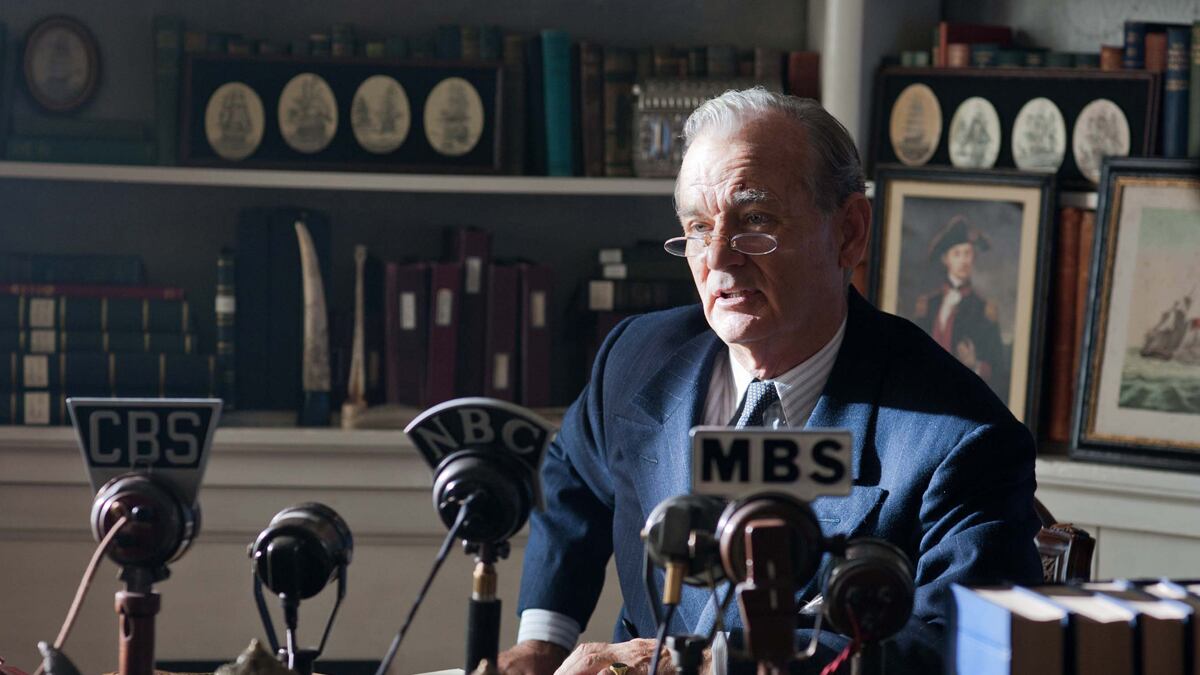Early on in the film Hyde Park on Hudson, President Franklin Delano Roosevelt, played by Bill Murray, takes a leisurely drive in his convertible through the flowery fields of his country estate in Hyde Park, N.Y. Since a battle with polio stripped him of the use of his legs, the vehicle is equipped with custom-made hand controls, as well as a nifty machine dispensing prelit cigarettes.
Seated beside him is his fifth cousin Margaret Suckley (Laura Linney).
Up to this point, the two have engaged in light flirtation, including the occasional joyride. On this particular trip, the president decides to wave off the police cruiser tailing him and forges a new path through the fields. He parks the car at the top of a hill overlooking the arresting meadows below, turns the radio up, and procures a smoke. Then he takes Suckley’s hand and slowly places it on his thigh. She is shocked, but intrigued. The president casually unzips his fly, and Suckley, ever the doting consort, gives him a handjob.
“I knew that we were not only fifth cousins, but very good friends,” she says in voice-over.
Indeed, a large part of filmmaker Roger Michell’s gloriously lensed, expertly acted crowd pleaser focuses on President Roosevelt’s love affair with Suckley, who was summoned by his overbearing mother to “care” for him during his time in Hyde Park in 1939. He confides in her, and she, too, grows to care for the ailing, deeply charismatic commander in chief.
“Most of the scenes in the film happened behind closed doors, so I think you have to take every historical film as a version of those events,” said Michell after a screening of the film. “I don’t think it’s an irresponsible lurch into the improbable. It’s very probable.”
In the film, despite his seemingly earnest affection toward Suckley, FDR is portrayed as a bit of a philanderer, bedding members of his staff. His rampant infidelity is even pinpointed as the root cause of wife Eleanor’s romantic indifference (an assumption that FDR scholars will surely take issue with). Murray, in a postscreening Q and A, said he understood FDR’s predilection for the company of women.

“On a movie set, you have to work an unbelievably long day, and there’s a certain kind of energy we have to have to create that women provide,” he said. “It’s very difficult to work on a movie set if there aren’t women on the set.”
He continued: “There’s a certain energy that women have that keeps you bouncing. It’s not about sex; it’s that sex energy that you use to create. You know what these presidents look like after four years? They look like male models before, and then they look like undertakers after—except Reagan, but he didn’t work, so it’s OK. A guy that works the hours that that guy had to work, and given his [disability], he needed that special energy just to keep pushing through.”
Despite his questionable, borderline queasy behavior, FDR is never perceived as wicked in the slightest. Thanks to Michell’s restraint—we never see the former president engaged in, say, a wheelchair-riding sex act on camera (or any, for that matter)—and Murray’s eminent likability, FDR is a charming, jocular man who required the company of women to help his polio-stricken machine run (echoing Murray’s statements). He’s incredibly at ease with himself, whether being carried around by a butler or struggling to walk by swiveling his torso, his legs cast in iron braces. Every time he lets out his signature laugh—tilting his head all the way back and revealing a toothy smile—one can’t help but smile along with him.
The other, more interesting part of Michell’s film focuses on the June 1939 visit of King George VI (Samuel West) and his wife, Queen Elizabeth (Olivia Colman), to FDR’s estate in Hyde Park. It was the first visit by a British monarch to the U.S., with the king desperately hoping to bolster American support for his country on the eve of World War II. Although the specter of war looms large, much of the film’s laughs come thanks to a series of cheeky fish-out-of-water jokes involving the buttoned-up royals—brilliantly played by West and Colman—including the latter’s crippling fear of hot dogs.
Because both films include King George VI and are set mere weeks apart, Hyde Park on Hudson is destined to draw comparisons to 2010’s The King’s Speech, which won four Academy Awards, including Best Actor (Colin Firth), Best Director (Tom Hooper), and Best Picture. While Michell’s film is less operatic in scope, it’s captivating nonetheless, anchored by an Oscar-worthy performance by Murray.
The scene everyone will be talking about come awards time happens in President Roosevelt’s study. It’s early in the morning, and after a night of alcohol-fueled revelry, the King is summoned to the room. He’s nervous. The fate of his country may depend on this. After exchanging a few pleasantries, the king reaches into his coat pocket for a prepared statement. Fumbling over the words, he shouts, “This goddammed stutter!” The president stares at him, his kind eyes emanating genuine compassion through his granddad spectacles. “What stutter?” he replies. “This goddammed polio.” They share a knowing smile.
“He had incredible willpower,” said Murray. “It’s very challenging to play someone who’s an American icon. He’s a big guy.” He pauses. “He’s on the dime!”




